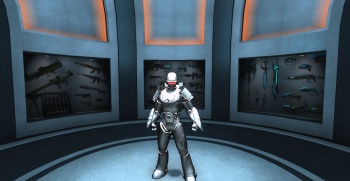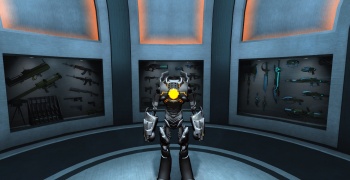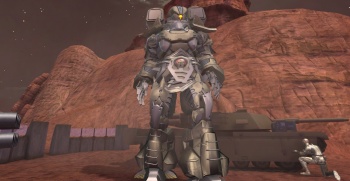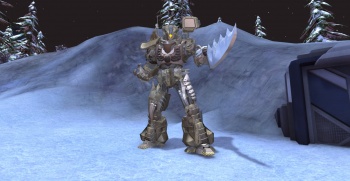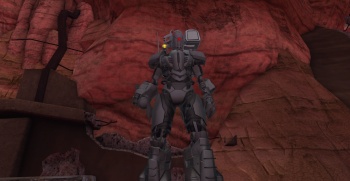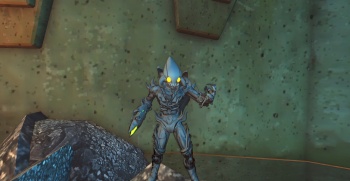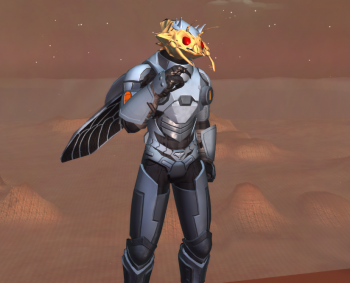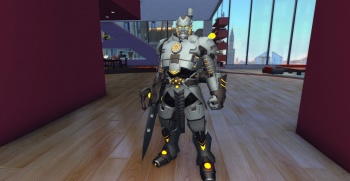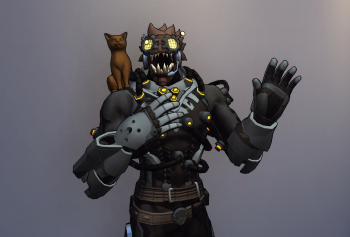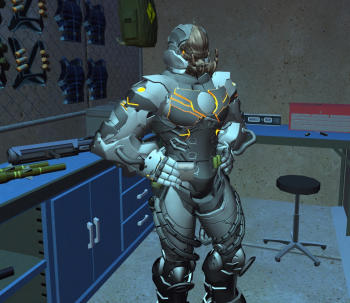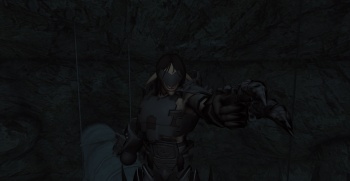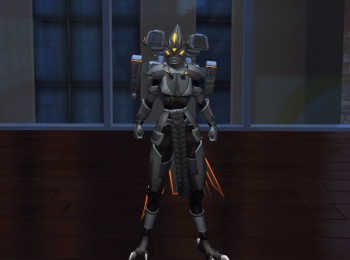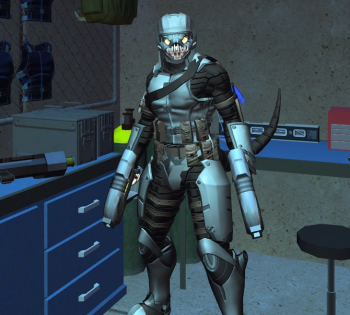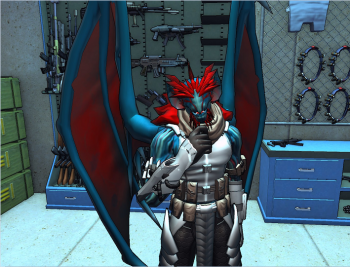Difference between revisions of "Ardacorp"
| Line 43: | Line 43: | ||
Ardacorp's first automated infantry unit was the "ACRP-ICD-001", an acronym for "Intelligent Combat Droid"; it had a basic AI, controlled by a non-localised central mainframe, which would often be situated safely within a headquarters. The ICD ran with the concept of "quantity over quality", and were built with fairly inexpensive materials, but their programming often led to confusion when in combat. Of course, the company sought to improve the performance of the ICD; despite being so cost-effective, the unit did not perform to the high standard required, and replacing trained soldiers with them would be a laughable notion. It took Ardacorp over 6 years to produce a new unit that was reliable enough to be used as conventional infantry. The ICD series ended with the Mk.4, which turned out to be too expensive to mass-produce. | Ardacorp's first automated infantry unit was the "ACRP-ICD-001", an acronym for "Intelligent Combat Droid"; it had a basic AI, controlled by a non-localised central mainframe, which would often be situated safely within a headquarters. The ICD ran with the concept of "quantity over quality", and were built with fairly inexpensive materials, but their programming often led to confusion when in combat. Of course, the company sought to improve the performance of the ICD; despite being so cost-effective, the unit did not perform to the high standard required, and replacing trained soldiers with them would be a laughable notion. It took Ardacorp over 6 years to produce a new unit that was reliable enough to be used as conventional infantry. The ICD series ended with the Mk.4, which turned out to be too expensive to mass-produce. | ||
| − | |||
| − | |||
[[image:Screenshot_2014-09-25-16-29-27.jpg|350px|thumb|center|'''The Cyclops, standard variant''']] | [[image:Screenshot_2014-09-25-16-29-27.jpg|350px|thumb|center|'''The Cyclops, standard variant''']] | ||
| − | Since the closure of the ICD series, Ardacorp had moved forward in the field of robotics; introducing the Cyclops. | + | Since the closure of the ICD series, Ardacorp had moved forward in the field of robotics; introducing the Cyclops. It proved to be a roaring success in action, outclassing the ICD's combat performance, and cheaper to produce than the ICD Mk.4. One of the key design features of the Cyclops is the complete lack of a head, which cuts production costs and expands the budget for other areas; the drone's torso naturally had to be made larger to accommodate sensory equipment. Thanks to advances in energy weapons research, the Cyclops was fitted with particle projectors in place of arms. '''The Cyclops Mk.1 was replaced with the upgraded Mk. 2 on the 16th of December, 2010.''' |
[[File:Cyclops Mk.2.png|350px|thumb|center|'''The Cyclops Mk. 2''']] | [[File:Cyclops Mk.2.png|350px|thumb|center|'''The Cyclops Mk. 2''']] | ||
| − | The Mk. 2 Cyclops | + | The Mk. 2 Cyclops looks strikingly similar to its predecessor; the main difference can be seen on its torso section -- the body of the original was swapped out for a new design that allowed for more sophisticated optical equipment to be mounted; an armoured ring encircling the camera array, providing additional protection, is also present. Aside from that, upgraded hardware was installed inside the new chassis, including a more economical micro-filament generator - which became a widely used piece of technology within company products. |
Revision as of 14:56, 30 October 2018
|
The following in-universe content has been declared by the author to be locked information that is either classified or yet to be revealed to other characters. Do not attempt to use this information in-universe. The author requires you to ask for consent before using any of the content below. |
.
|
The author of this article has marked this as a creative work, and would prefer that other users not edit it. Please respect this, and unless repairing a typo, spelling, or other minor technical error, think of this page as read-only. |
Do you own a business or an institution that needs protection? Are you responsible for the safe keeping of financial assets, government property, or sensitive materials? Then your solution is clear: Ardacorp. Originally a CCTV developer, we have been involved in the business of security since our foundation in 1987, and have progressed to providing additional means of protection; alarm systems, weaponised cameras, infrared laser tripwires, electroplate floor conversion, and optical camouflage sensors are just a few of the services we offer for one-time payments.
If you'd prefer something a little more mobile, or perhaps want to add something alongside your fixed security systems, we also offer self-guiding drones, as well as server installation for monthly fees; but if none of that takes your fancy, we can always throw a well-trained agent your way for varying monthly costs. Seen anything you like yet?
If the answer is yes, then head over to our website at www.ardacorp.com to browse our product line; alternatively, you may give us a call on 0196619870 and speak to a non-automated advisor (call costs vary with provider).
Do not delay – your security depends on it.
Contents
Overview
Ardacorp began as an automated security company, producing cameras and alarm systems for commercial, as well as private properties. Its CEO, Victor Ardaman, set up the company in 1987, based in North Carolina; Ardaman's business was pooling in a fair profit, largely because of his own obsession with cost efficiency - so large amounts of resources and time were spent in the research and development of materials to support this philosophy. In late 1995, the company evolved to producing cameras with built-in weapon systems; these were purchased by other licensed businesses and property owners to protect high-priority buildings.
Staying true to its roots, Ardacorp stuck with the development of security cameras, but began moving in the direction of mobile systems: robots. Initially, it began with the company's first automated unit, known as the 'Incursion Drone'; They were small, quadruped mobile robots that housed many sensors within domes found at front of their bodies, in place of where a head would normally be found on a four-legged animal; they were based on the idea of a hive mind, all of the drones linked to one (or several) mainframes that ran specifically to keep them all online and issue necessary commands to the units; the mainframes were also built by Ardacorp, and installed into properties that requested an order (which could even be ONE) of drones. It was then that Ardaman came to a realisation; if he developed machines that could be used in place of human soldiers during times of conflict, he could both save lives and open up a whole new window of opportunity to his company; He saw the implications of using people as soldiers - the cost of supplying each individual with their own personal armament, as well as the time and training needed to create battle-ready troops.
Technological advancement
The first truly autonomous robotic unit developed by the company, Argus Drones are designed as a mobile spy platform; small and highly agile, the unit is able to quickly traverse terrain and climb up sheer surfaces with specialised claws, allowing it to access areas that would otherwise prove difficult for humans to reach. Each Drone possesses an opaque dome at the front, which contains a sophisticated sensor array for perceiving a variety of things, including: light, sound, temperature, and even harmful airborn chemicals. If necessary, Argus Drones can also be converted into mobile bombs by replacing most of their expensive sensor equipment with an explosive charge; this variant of drone is highlighted by the vibrant red colouring of its frontal dome.
Ardacorp's first automated infantry unit was the "ACRP-ICD-001", an acronym for "Intelligent Combat Droid"; it had a basic AI, controlled by a non-localised central mainframe, which would often be situated safely within a headquarters. The ICD ran with the concept of "quantity over quality", and were built with fairly inexpensive materials, but their programming often led to confusion when in combat. Of course, the company sought to improve the performance of the ICD; despite being so cost-effective, the unit did not perform to the high standard required, and replacing trained soldiers with them would be a laughable notion. It took Ardacorp over 6 years to produce a new unit that was reliable enough to be used as conventional infantry. The ICD series ended with the Mk.4, which turned out to be too expensive to mass-produce.
Since the closure of the ICD series, Ardacorp had moved forward in the field of robotics; introducing the Cyclops. It proved to be a roaring success in action, outclassing the ICD's combat performance, and cheaper to produce than the ICD Mk.4. One of the key design features of the Cyclops is the complete lack of a head, which cuts production costs and expands the budget for other areas; the drone's torso naturally had to be made larger to accommodate sensory equipment. Thanks to advances in energy weapons research, the Cyclops was fitted with particle projectors in place of arms. The Cyclops Mk.1 was replaced with the upgraded Mk. 2 on the 16th of December, 2010.
The Mk. 2 Cyclops looks strikingly similar to its predecessor; the main difference can be seen on its torso section -- the body of the original was swapped out for a new design that allowed for more sophisticated optical equipment to be mounted; an armoured ring encircling the camera array, providing additional protection, is also present. Aside from that, upgraded hardware was installed inside the new chassis, including a more economical micro-filament generator - which became a widely used piece of technology within company products.
Manually Operated Units
Ardacorp might have began as an automated security firm, but Ardaman isn't one for limitations when it comes to profit; after all, he was already trying to crack open the military market, so manually operated products were surely something that needed to be considered; Sadly, at times, AIs and robots can become faulty -- piloted machines are considered to be safer, by some.
So, with heavy firepower seemingly in high demand, the company gave birth to the Comet in 2004. It was a towering, mechanized powerhouse, featuring a number of inbuilt weapon systems that gave it an unprecedented level of offense. The cockpit was found within the torso; an armoured hatch on the front of its body allowed entry to the pilot's seat -- digital displays linked up to the Comet's cyclopean optic, as well as cameras mounted on both arms, would be used instead of a conventional windshield or viewscreen; this gave the driver increased levels of protection, which made the Comet a favorable choice amongst Ardacorp's larger and more wealthy clientele. The Comet was the company's first batch-produced product. Over six-hundred are estimated to have been built.
In fact, the Comet was so popular, that second-hand units began to appear on the black market. Company forces were dispatched to Alaska in order to eliminate a modified Comet unit, within the hands of armed Russian insurgents reported around Wainwright, to the North. Some of the unit's armour had been removed and replaced with custom-built plates, a missile pod was missing, and its left arm was replaced with a reinforced steel blade; it was assumed that if the modified Comet were left unopposed, the insurgents would've completely re-armoured it, and possibly added additional weaponry.
After two years of the Mark 1 being in service, its successor emerged. Some parts from the original were used on the Mark 2, but its visual design was totally different. It had a lower overall weight, making it more mobile - despite this, its defenses were barely compromised; however, its range of weaponry was more limited, and it had no offensive systems stored inside its paneling; instead, it made use of a 105mm cannon, mounted upon its right arm, along with a coaxial 20mm auto-gun. On its left arm, it mounted Ardacorp's first energy efficient laser blade, which concentrated enough heat to slice through a majority of conventional armour materials less than 100mm thick within a short timeframe. The Mk. 2 discarded one of the original's missile pods in favor of additional sensory and communications equipment, as well as a spotlight.
Considering the production cost of the Mark 2 Comet, Ardacorp decided to greenflag a new and more cost-efficient model for production, after rigorous testing. The new 'Amarok' unit was far superior to the previous Comet models when it came to economics, once again thanks to the complete lack of a head - which removed the need for many expensive components; instead, a cockpit with digital Heads-Up-Display was implemented, and special cameras were mounted on the torso to help with target acquisition. Instead of solid ammunition weaponry, the Amarok makes use of a large-scale particle cannon, taking up the entirety of its right arm and powered by the unit's generator, which is comprised of many high output micro-filament batteries. A Questionite alloy high frequency blade is mounted upon the Amarok's left arm, which is able to rapidly saw back and forth at a rate of twelve cycles per second, allowing for immense cutting power.
The ABRAD absorption
Shortly after the Cyclops Mk. 1's introduction in 1995, Ardaman had considered an alternative to robotics which could possibly reduce production costs tenfold; they would attempt to create a biological soldier. The aim was to make them non-sentient, lacking any real human emotion aside from anger or, when necessary, fear. Only the most basic primal instincts were to be implemented within these soldiers. They wouldn't require armour, or weaponry; everything would be grown 'naturally', equaling more profit for Victor's company.
However, it wasn't Ardacorp that pursued this goal single-handed; they didn't have the resources, staff, or facilities to even begin work in this field - one they had no previous experience with; which is why Ardaman instead approached a string of stem cell research labs, known collectively as 'ABRAD' (American Biological Research and Development), buying out their sites and scientists in order to fulfill his wishes.
After eight years of research, Ardacorp finally managed to develop the "Cerberus". This was to be known as the company's first biologically-engineered creature. It was large, standing at around 3 meters tall; it was a ferocious and largely feared unit, but it was too expensive and imperfect to mass-produce. The Cerberus took two years to fully mature, and only five were ever grown. The expense was due to the cybernetic implants needed to keep the creature alive; various life-sustaining pieces of equipment were necessary, or it would die. Ardacorp's newly-acquired bio-engineering labs were fairly sophisticated, but the scientists involved in the project were still unable to yield a self-sustaining lifeform due to inexperience with growing man-made organisms.
Around five years later, the Crusader was born. This new unit stood as tall as 7ft, a bit bigger than the average man; it adopted a hunched posture, much like the Cerberus, but it was different; the Crusader made use of a biologically-engineered weapon, grown from its right arm, that used muscles to squirt corrosive biogel produced by specialised glands, and onto anyone unfortunate enough to be stood in the way. Unlike its predecessor, the Crusader was totally void of cybernetics; it was able to sustain itself without the need of machinery, and had an estimated lifespan of ten years.
They were superior to any soldier because of their short maturation period; it took only two months from birth for a single Crusader to fully mature, ready for combat.
February 23rd 2008, United States Army audience
The following text is the written translation of an audio recording with Victor Ardaman, Ardacorp CEO, whilst attending a formal meeting arranged with the US Army:
Army Representative (AR): “Mister Ardaman, welcome.” AR rises from a chair placed behind a desk, extending their right arm towards Ardaman in offering of a handshake.
Victor Ardaman (VA): “Hello, thank you.” Ardaman takes AR's hand in his own and completes the handshake, before sitting down in the chair on the opposite side of the table to AR, who simultaneously sits in their own.
AR: “So, I understand that, after your last arrangement with us, things have changed?” AR leans on the table with both arms, intently awaiting VA's response.
VA: “W-Well; not quite.” VA pauses. “I actually came to ask a question – and discuss it, of course... I've had a...” VA once again pauses. “An idea, really.”.
AR: “An idea. I see; well, please go ahead.” AR gestures with a hand for VA to continue.
VA: “Putting Ardacorp's mechanised infantry aside... I was thinking; say... Theoretically... What if a soldier – that could outclass a human with regards to combat performance – was able to be grown, from scratch, and required no additional help.” VA pauses. “As in... Equipment. Guns, armour, anything.” VA pauses again, before raising a finger and stating: “Now that IS theoretical, of course...” VA appears to fidget.
AR: AR observes VA's body language for a moment, faintly raising an eyebrow before responding. “Alright... Well, that concept would be good if said 'soldier' could be grown in a reasonable amount of time.”, VA seems incredibly eager to answer.
VA: “I knew you'd say that – which is why I was-”, once again, VA pauses. “Nevermind; so... Within a reasonable amount of time. How does, say... Two weeks sound? Theoretically.” VA interlocks the fingers of his hands, leaning on the table with both elbows.
AR: “Your frequent use of 'theoretically' is a little unnecessary; you've already made it clear that it's a concept – and not a reality. Right?” AR tilts his head a little, with VA cutting in before AR can continue.
VA: “Absolutely – it's ludicrous to think of it as a reality.” VA chuckles, then shakes his head. “No, no – it's entirely theoretical.” VA blinks, perhaps realising his citing of 'theoretical'.
AR: AR pauses for a considerable time, watching VA. “Right... So – you're telling me that you've... 'Considered'...” AR appears to eye VA for a short time. “Growing soldiers for military use? And you're saying that you plan for them to only take two weeks growth time?”
VA: “Yes.”
AR: “So what will these soldiers be like, then?” AR once again raises an eyebrow, awaiting a response.
VA: “I should think they're a lot like animals.” VA pauses. “They'd BE a lot like animals, rather. They would have basic instincts – fear included; because it's rather a necessity for survival, is it not?” VA grins rather sheepishly. “But of course, it would take a bit to scare them – say... When a heavy loss is occurring. Anyway... They'd be grown with some sort of weapon already on them – a biological weapon; one that replenishes its own ammunition.”
AR: AR seems amused at the thought, shaking his head. “Mister Ardaman, are you aware of the implications of such an idea?”
VA: VA pauses for quite a while, an expression of bewilderment overcoming his face. “I...- What 'implications'? You mean-” AR cuts in.
AR: “I mean the fact that, as you said, they're animals. What if we needed to send them into a conflict where civilians are present? An occurrence like that happens quite a lot in this day and age. They'd be absolutely terrified of these...”, he pauses with a smirk, “Okay – they're practically monsters, from what you're suggesting. They'd be terrified of these monsters around them; and the United States Army does not terrorise civilians.” VA doesn't offer a reply, despite AR's pausing. AR continues: “Human soldiers can think properly, and don't rely solely on instinct to carry out a mission; they can communicate – and that's a very good point, actually; how will these things speak?”
VA: “No – you're right. It's a far-fetched idea.” VA shakes his head, with AR crossing their arms. “I'd just considered alternative ways of reducing military costs.”
AR: “And we'd be happy to accept your alternative ways, if they prove to be efficient.”
VA: VA looks at AR silently for a short while, seemingly deep in thought. VA eventually nods. “Thank you for your time – and I'm sorry if you feel it's been wasted.”, VA stands up, offering his right hand to AR for a handshake.
AR: “Not at all.”, AR stands up and completes the handshake, VA turning to leave shortly after.
The sound of a door can be heard closing in the background. AR addresses a colleague through the one-way glass allowing sight into the interview room:
AR: AR chuckles, knowing VA isn't in earshot. “Was he being completely serious? Growing monsters to replace soldiers – that's fucking ridiculous.”
The audio recording ends there.
The mass burning of March 12th
After the United States Army audience that Ardaman had arranged to discuss the 'concept' of his Crusader units, he was incredibly displeased with the response they gave. Considering the disapproval of the Army, and the units having no other real use aside from being terror weapons, the CEO ordered a mass burning of the creatures; a cruel, but necessary (he felt) solution to this new 'problem'; and so, on the 12th of March, 2008, Ardacorp staff gathered up the Crusaders into large pens, outside, not far from the company's outpost situated in Denver, torching the masses of monstrous products - much to the beasts' dismay, bellowing out agonized cries and terrifying screeches.
Some residents of Denver, present in the city at the time, reported to have smelt a strong barbecue scent.
Playing God
By 2008, Ardacorp's biological research and development department had garnered much experience from the Crusader project. However, because of the failed 'pitch' made by Ardaman, the company had to shift its focus a little, in search of a product with more intellect. Instead of creating organisms from scratch, they would begin to integrate alternative DNA into embryos, attempting to find the perfect recipe. Some of the scientists that Ardacorp had hired already experimented with Qularr subjects in the past, so this was a perfect starting point; using a small clutch of frozen Qularr embryos, which had been kept in preservation since early 1966, the company created four successful products that incorporated Qularr and human DNA. All of the subjects were given "meta genes" of varying type; cryokinesis, pryokinesis, electrokinesis and gyrokinesis.
In order to speed things up, the successful subjects were suspended within gel-filled tanks. The substance inside the tanks was actually a healing bio-gel, which happened to be a byproduct from the Crusader project - but this time, it was being used as a catalyst to support the subjects' growth. By the end of the year, they were all fully grown, and had attained the biological age of thirty. Artificial memories were implanted into their brains. Unfortunately, the electrokinetic embryo had developed incorrectly, and was missing both of its arms; this problem was remedied through the use of cybernetic augmentation.
Despite all of the work that was put into the creation of these Qularr-human subjects, a terrible incident involving the Qularr invasion of 2009 had led to the escape of the four meta subjects. Suffering from high levels of psychological trauma because of the Beacons, the subjects used their abilities to wreak havoc within the facility, causing the deaths of several scientists and responding security personnel, in order to free themselves from the lab. This was an incredibly detrimental event for Ardacorp; not only had their facility been heavily damaged and employees killed, but their newest successful subjects, which were intended for transfer into the Monster Squad programme, had also gotten loose.
The Monster Squad
The Monster Squad is an elite fighting unit formed upon CEO Victor Ardaman's request after a formal meeting with his team of biologists – ex-ABRAD scientists, formerly devoted to the practice of stem cell research. The Crusader project blossomed; it was the catalyst for additional breakthroughs (such as the creation of a healing bio-gel), and provided the company with an effective soldier... But the Crusaders themselves didn't quite cut it. The company needed something more intelligent. The Monster Squad was the answer.
The unit was to be composed only of the most successful experiments – the wheat among the chaff. Many were malformed fetuses or, more commonly, lumps of basic living matter with no proper function or use – but those chosen for the Squad were marvels of the (un)natural world, sporting intellect, strength, or agility that far and away surpassed their Crusader brothers. It was no longer about building an army, but about assembling a compact force that could topple one.
Subject-N04, aka Xintos, was one of the original four intended for transfer into the Monster Squad programme (See "Playing God"); after nine years, the company were able to reclaim him, and have now successfully integrated Xintos into the unit. A headstrong personality mixed with the destructive ability of pyrokinesis, along with his superhuman resilience and flesh possessing non-Newtonian properties, makes Xintos a formidable warrior. He is likely the most dangerous squad member, and his potential for mass devastation is unprecedented; the manipulation of extreme temperature allows him to incinerate almost anything in his path, and he has devised many creative ways to utilise his powers throughout his many engagements, such as depriving targets of breathable air through the use of convection currents. Xintos' highest recorded temperature is 8,132c, but he is theoretically capable of achieving more than this; unfortunately, because of an exponential increase in his body's metabolic rate due to higher heat output, he must wear an inhibitor at all times to moderate it; with this inhibitor active, Subject-N04's maximum temperature is capped at around 2,000c, in order to avoid burnout and, eventually, death.
Subject-N13 was officially the first successful post-Crusader product to be grown from scratch. A severely deformed individual, 'Titan', as he likes to be known, was 'born' without arms, and required extensive cybernetic augmentation – including the need for limited life-sustaining enhancements due to malformed lungs; the result was an amalgamation of crimson flesh and metal, a hulking figure of over seven feet tall, Titan is a force to be reckoned with when it comes to brute strength – and he even has an admirable level of intellect to compliment it, avoiding the typical “all brawn and no brains” stereotype. The subject became a test unit for Ardacorp's '3GEN' nanites – tiny, bug-like robots with incredibly basic functions; they were programmed to scuttle along Titan's body, repairing any inflicted damage – even being able to recycle material from the armour that the creature wears into a wide range of weaponry, making N13 a very diverse and adaptable fighter.
Subject-N18 was grown using various feline genes along with human DNA. Codenamed 'Hackman', this sly creature was exemplary because of his affinity for computer systems - an unexpected trait that became apparent after a particular incident; nonetheless, this perk proved valuable in practice. Capable of an astonishingly fast sprint speed, N18 was known for crossing long distances in a short amount of time; this, in combination with his lean and nimble body, made him an effective scout for routing out enemy positions and keeping the opposition on their toes when infiltration was no longer an option. N18's hacking skills came in handy if a less 'hands-on' approach was necessary, disabling security systems or accessing hidden digital information when the need arose. However, his strange fascination for cats often led to complications during operations, and he was deemed a liability. Subject-N18 was disposed of on April 16th, 2015.
Subject-N24 is a blend of rhinoceros and human DNA, gifted with psionic meta genes during his initial formation process. The result was... initially not as successful as the company had hoped. Due to abnormal growth, N24 came out as just a torso and head, but was spared from genetic repurposing when the company realised how quickly his psionic powers were developing. Despite being capable of everything a human could, due to his extraordinary ability to manipulate the world around him using only the power of his mind, N24 was assigned custom-built cybernetic limbs to act in place of the ones he never had; Ardacorp deemed these prosthetics as a necessity to reduce the amount of passive mental strain that came with him having to constantly levitate his own body, and lift objects without hands. The end product was a halfway between biological and mechanical, with the potential to crush whole buildings through telekinesis. N24 primarily acts as long-range support for the squad, putting his specialised marksman training to use as a sniper equipped with a heavy DEW (directed energy weapon) - a terrifying armament in the hands of a soldier, but even scarier when said soldier can detect his targets through walls via telepathy.
Subject-N27, as far as Monster Squad members go, was easily the strangest. Codenamed 'Reaper', he was 'born' without legs and a right arm – making him one of the most malformed of any 'successful' product; but Reaper had a heart and willpower strong enough to compensate for his physical setbacks. Like others before him, Reaper was enhanced with cybernetics, being given a set of expensive reverse-jointed mechanical legs, and a right arm limb replacement – effectively an articulated auto-gun; it served no other purpose besides literally shredding the life out of anyone, or anything, unfortunate enough to be on the company's hit list. N27 did, however, have a fully functioning set of organs within his perfectly-formed torso, and his left arm seemed fine; his face, however... His face was something else. The most prominent feature of the creature's mug was easily the large grin he permanently wore, his teeth shown in their full glory within a beaming smile that stretched from ear to ear. But it wasn't a happy one; on the contrary, Reaper was incredibly envious of the more 'perfect' subjects – even Titan, despite his physical abnormalities; Reaper had more, and he hated it. Despite this, he hid his feelings behind a veil of twisted humour, allowing his victims to be the ones to bare his bottled-up emotions – usually resulting in their dismemberment. It was eventually decided that his unpredictable outbursts were too much of an inconvenience. Subject-N27 was disposed of on January 9th, 2016.
Subject-N36, also known as 'Salvo', is a genetic hybrid between a kangaroo and a human. Using her powerful legs to jump up to twelve feet high, supported by a set of jump jets mounted to her back, means N36 can achieve vertical distances of up to eighteen feet. A pair of missile pods built onto her backpack grants Salvo the ability to rain death upon her enemies from her maximum jump height; this gives her the potential to wipe out entire squads of infantry, and even pose a significant threat to armored targets, depending on the type of ammunition she has on hand at the time. Specialised cybernetics designed to absorb impacts were implemented to support Salvo's legs because of the extra boost provided by her thrusters and, like all Squad members, she received training in handling firearms if there's danger close.
Subject-N52 claimed the title of 'Hunter', and was grown using an altered genetic template from the older Crusader units, possessing some similar physical features – such as the long, exclusively canine teeth and muscular tail; the main difference is that he looks more... Human. N52 stands at just over seven foot tall, sharing the pinkish complexion of Caucasian skin; but the monstrous head, teeth and tail betray any claim to humanity. Hunter formed perfectly throughout his growth phase, requiring no cybernetic aid to support life; among staff members, it is widely regarded as the perfect soldier, naturally strong and dexterous with sharp senses, and boasting rapid regeneration. Hunter received extensive training for handling various firearms, but primarily makes use of two heavy repeating particle blasters; these experimental energy-based weapons are capable of firing volleys of dangerously hot atoms, with enough force to punch through most lightly armoured vehicles.
Subject-N61, or 'Stalker', is a curious mixture of chiropteran, reptilian, and human DNA - by far the most complex Monster Squad member ever grown. Capable of long-distance and near-silent flight with a pair of leathery wings, N61 is considered one of the most mobile squad members; this, coupled with his chameleon-like skin and highly agile form, makes N61 the stealthiest, too. Specialising in infiltration and blitz tactics, Stalker fulfils the role of a vanguard; when necessary, he is able to use his quick reflexes to outpace his opponents in direct combat through the use of firearms and trained CQC techniques. However, he is also able to secrete a potent neurotoxin through sweat glands, and assail his quarry with venomous quills that grow upon his scaly body. To top it all off, his seemingly toothless maw hides away a set of deadly retractable fangs and a disturbingly long tongue, ideal for pulling in and silencing hapless victims.
Staff Roster
Like all businesses, small or large, Ardacorp has many employees that all contribute towards the company in one way or another. This section displays important or notable members of staff.
The CEO
Victor Ardaman
Administrators and Operators
Harry Saunders
Engineers and Mechanics
Alexander Suffolk
Jovan "Achilles" Pasic
Scientists
Maria "Lucidia" Hewert
Sicilia Andronius
Shelly Lawrence
Researchers
Adrian Breets
Security Agents
Elizabeth "Regina" Hall
Katia "Rebel" Winnock
Test Pilots
James "Goat" Vitson
Independent Assets
Bornmueller Courier Services Co.
Artwork




